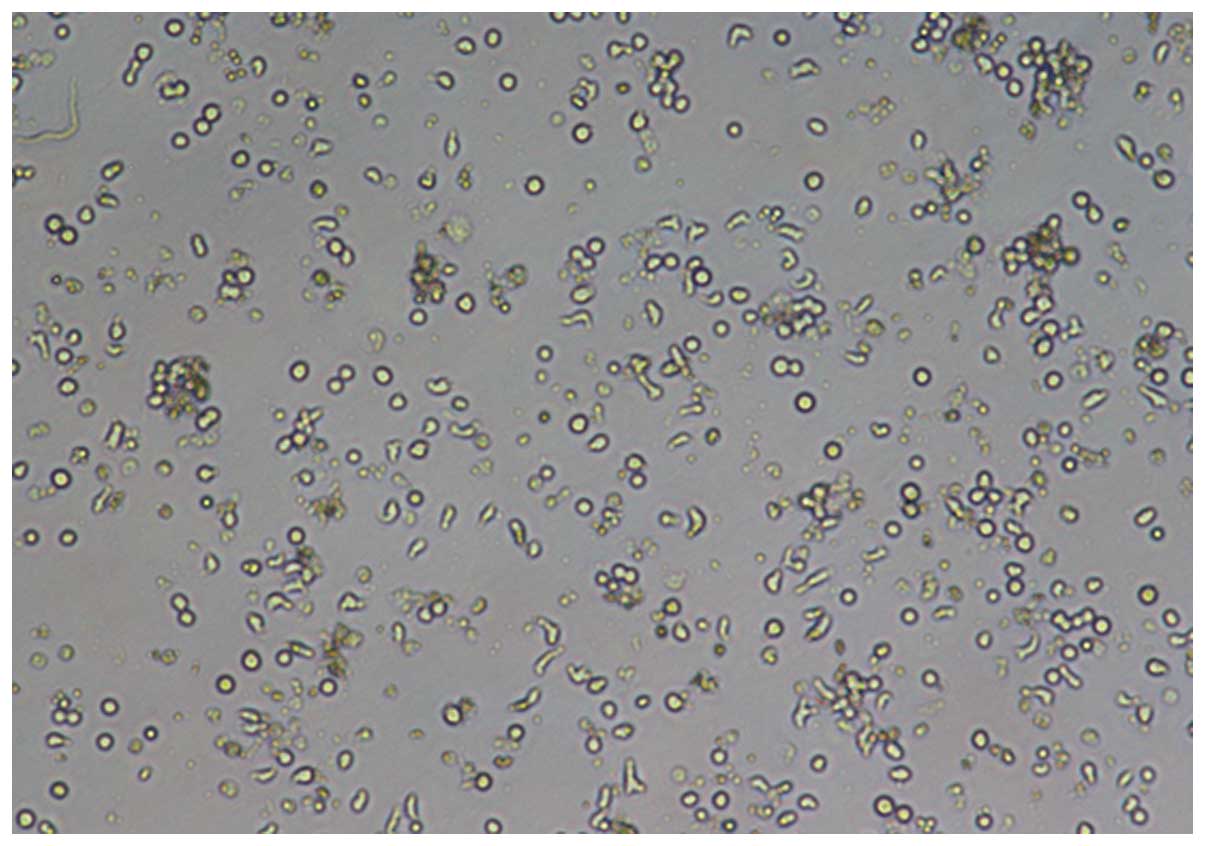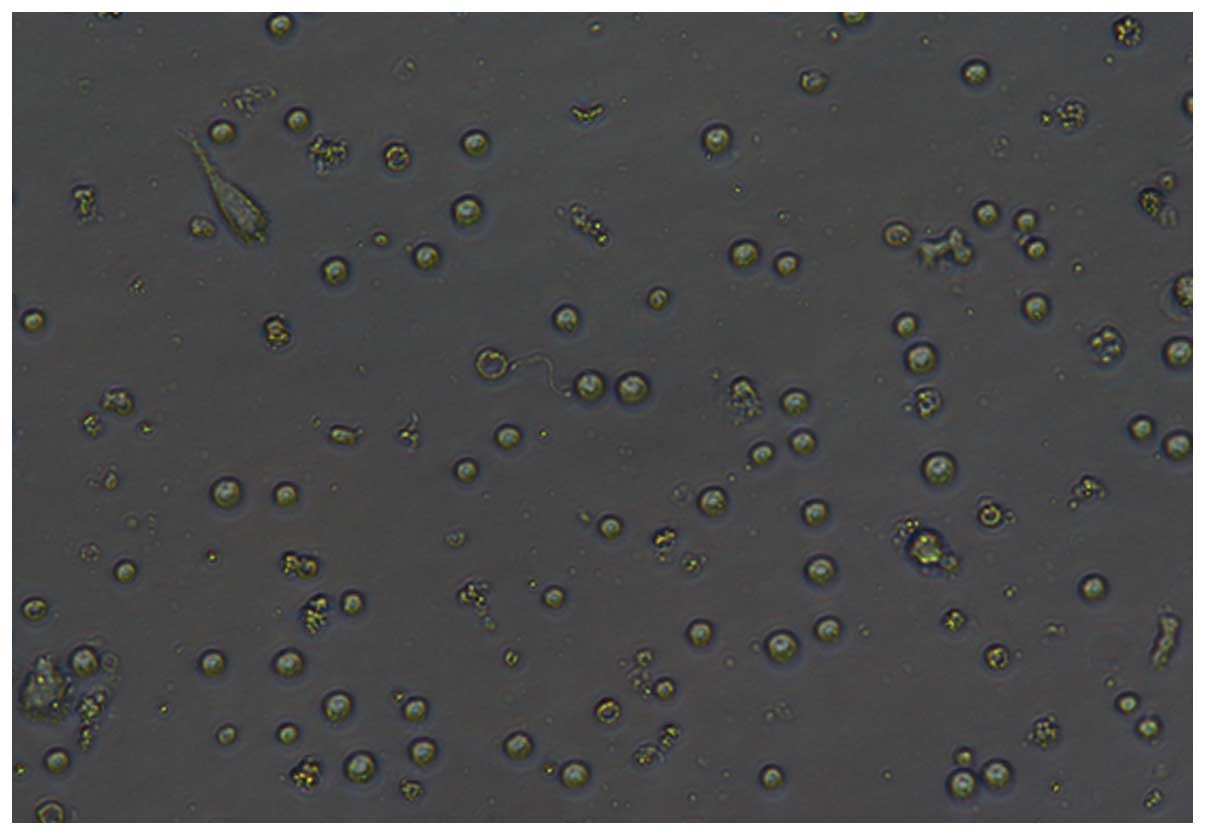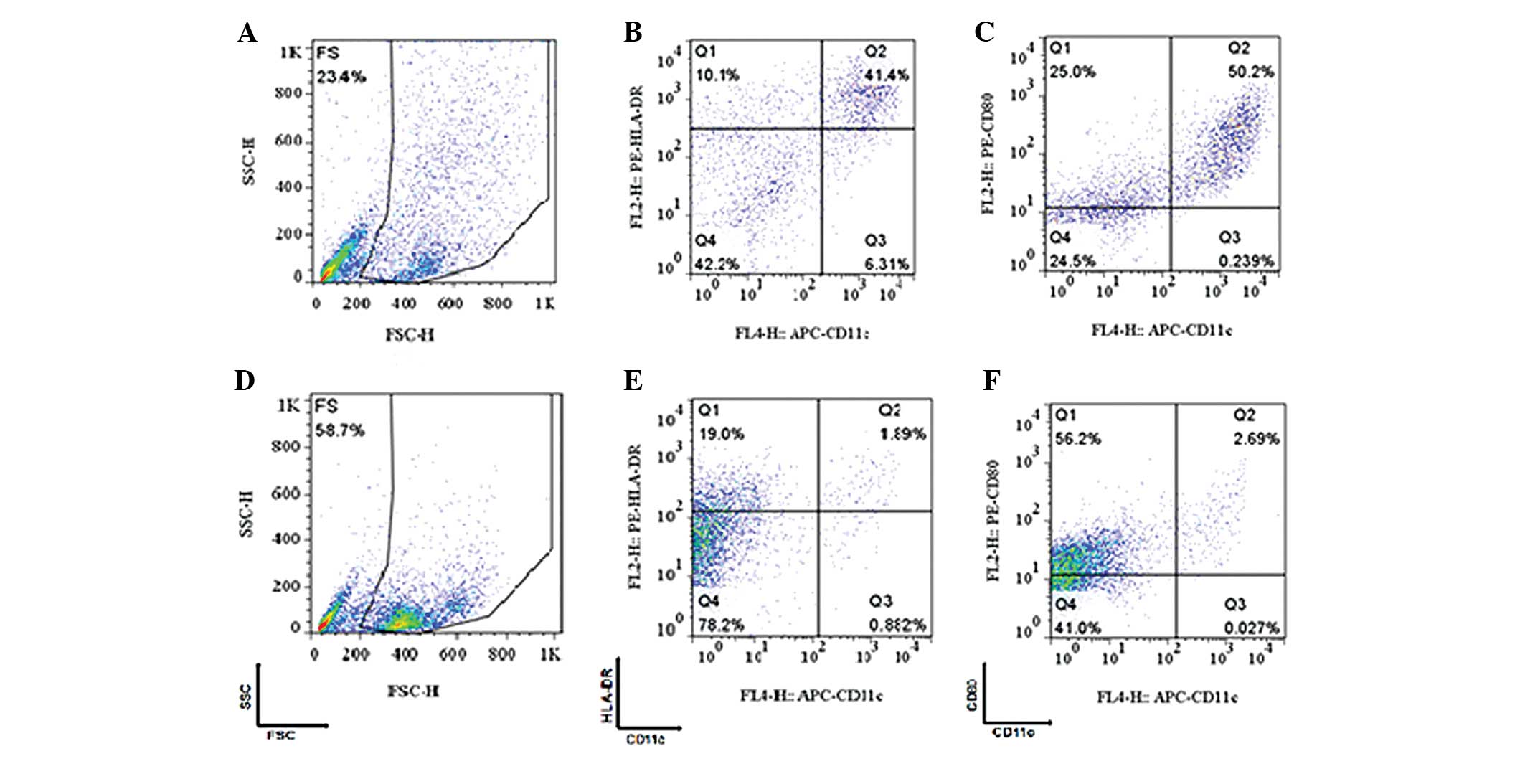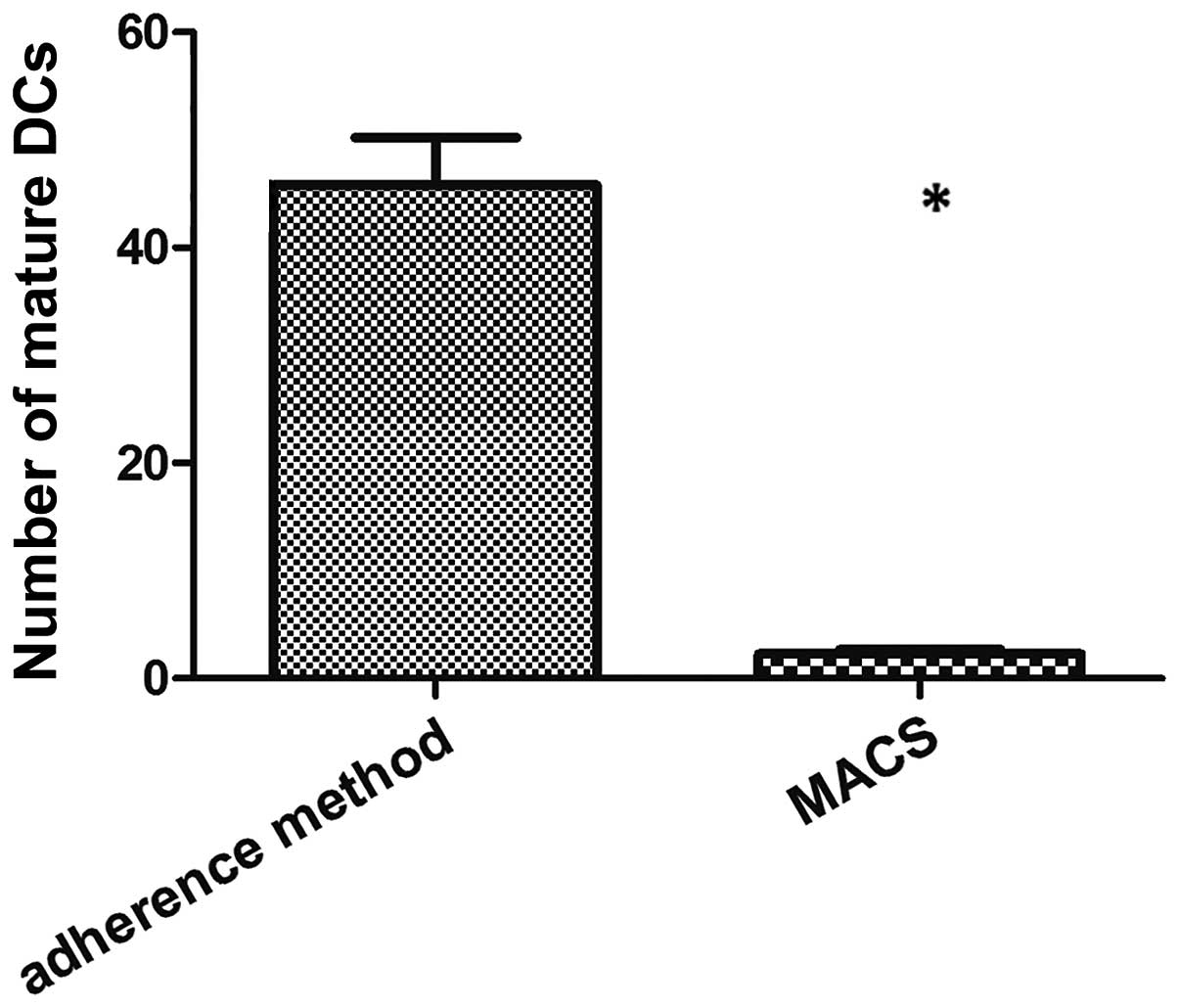|
1
|
Steinman RM and Cohn ZA: Identification of
a novel cell type in peripheral lymphoid organs of mice. I.
Morphology, quantitation, tissue distribution. J Exp Med.
137:1142–1162. 1973. View Article : Google Scholar : PubMed/NCBI
|
|
2
|
Banchereau J, Briere F, Caux C, et al:
Immunobiology of dendritic cells. Annu Rev Immunol. 18:767–811.
2000. View Article : Google Scholar : PubMed/NCBI
|
|
3
|
Schuler G, Schuler-Thurner B and Steinman
RM: The use of dendritic cells in cancer immunotherapy. Curr Opin
Immunol. 15:138–147. 2003. View Article : Google Scholar : PubMed/NCBI
|
|
4
|
Chu CS, Boyer J, Schullery DS, et al:
Phase I/II randomized trial of dendritic cell vaccination with or
without cyclophosphamide for consolidation therapy of advanced
ovarian cancer in first or second remission. Cancer Immunol
Immunother. 61:629–641. 2012. View Article : Google Scholar : PubMed/NCBI
|
|
5
|
Coosemans A, Vanderstraeten A, Tuyaerts S,
et al: Wilms' Tumor Gene 1 (WT1) - loaded dendritic cell
immunotherapy in patients with uterine tumors: a phase I/II
clinical trial. Anticancer Res. 33:5495–5500. 2013.PubMed/NCBI
|
|
6
|
Mody N, Dubey S, Sharma R, Agrawal U and
Vyas SP: Dendritic cell-based vaccine research against cancer.
Expert Rev Clin Immunol. 11:213–232. 2015. View Article : Google Scholar : PubMed/NCBI
|
|
7
|
GanjiBakhsh M, Nejati V, Delirezh N, Asadi
M and Gholami K: Mixture of fibroblast, epithelial and endothelial
cells conditioned media induce monocyte-derived dendritic cell
maturation. Cell Immunol. 272:18–24. 2011. View Article : Google Scholar : PubMed/NCBI
|
|
8
|
Delirezh N, Majedi L, Asri Rezaei S and
Ranjkeshzadeh H: Generation of mature monocyte-derived dendritic
cells in the presence of heparin and monocyte conditioned medium:
phenotypic and functional comparison. Iran Biomed J. 15:79–84.
2011.PubMed/NCBI
|
|
9
|
Takamizawa M, Rivas A, Fagnoni F, et al:
Dendritic cells that process and present nominal antigens to naive
T lymphocytes are derived from CD2+ precursors. J
Immunol. 158:2134–2142. 1997.PubMed/NCBI
|
|
10
|
Ito T, Inaba M, Inaba K, et al: A
CD1a+/CD11c+ subset of human blood dendritic cells is a direct
precursor of Langerhans cells. J Immunol. 163:1409–1419.
1999.PubMed/NCBI
|
|
11
|
Cella M, Jarrossay D, Facchetti F, et al:
Plasmacytoid monocytes migrate to inflamed lymph nodes and produce
large amounts of type I interferon. Nat Med. 5:919–923. 1999.
View Article : Google Scholar : PubMed/NCBI
|
|
12
|
Oehler L, Berer A, Keil F, et al:
Generation of dendritic cells from human chronic myelomonocytic
leukemia cells in fetal calf serum-free medium. Leuk Lymphoma.
38:577–586. 2000. View Article : Google Scholar : PubMed/NCBI
|
|
13
|
Ferlazzo G, Wesa A, Wei WZ and Galy A:
Dendritic cells generated either from CD34+ progenitor
cells or from monocytes differ in their ability to activate
antigen-specific CD8+ T cells. J Immunol. 163:3597–3604.
1999.PubMed/NCBI
|
|
14
|
Broxmeyer HE, Hangoc G, Cooper S, et al:
Growth characteristics and expansion of human umbilical cord blood
and estimation of its potential for transplantation in adults. Proc
Natl Acad Sci USA. 89:4109–4113. 1992. View Article : Google Scholar : PubMed/NCBI
|
|
15
|
Van Brussel I, Ammi R, Rombouts M, et al:
Fluorescent activated cell sorting: An effective approach to study
dendritic cell subsets in human atherosclerotic plaques. J Immunol
Methods. 417:76–85. 2015. View Article : Google Scholar : PubMed/NCBI
|
|
16
|
Caux C, Massacrier C, Vanbervliet B, et
al: CD34+ hematopoietic progenitors from human cord blood
differentiate along two independent dendritic cell pathways in
response to granulocyte-macrophage colony-stimulating factor plus
tumor necrosis factor alpha: II. Functional analysis. Blood.
90:1458–1470. 1997.PubMed/NCBI
|
|
17
|
Canque B, Camus S, Dalloul A, et al:
Characterization of dendritic cell differentiation pathways from
cord blood CD34(+) CD7(+)CD45RA(+) hematopoietic progenitor cells.
Blood. 96:3748–3756. 2000.PubMed/NCBI
|
|
18
|
Ferlazzo G, Klein J, Paliard X, Wei WZ and
Galy A: Dendritic cells generated from CD34+ progenitor cells with
flt3 ligand, c-kit ligand, GM-CSF, IL-4 and TNF-alpha are
functional antigen-presenting cells resembling mature
monocyte-derived dendritic cells. J Immunother. 23:48–58. 2000.
View Article : Google Scholar : PubMed/NCBI
|
|
19
|
Delirezh N, Shojaeefar E, Parvin P and
Asadi B: Comparison the effects of two monocyte isolation methods,
plastic adherence and magnetic activated cell sorting methods, on
phagocytic activity of generated dendritic cells. Cell J.
15:218–223. 2013.PubMed/NCBI
|
|
20
|
Delirezh N and Shojaeefar E: Phenotypic
and functional comparison between flask adherent and magnetic
activated cell sorted monocytes derived dendritic cells. Iran J
Immunol. 9:98–108. 2012.PubMed/NCBI
|
|
21
|
Mucci I, Legitimo A, Compagnino M, et al:
The methodological approach for the generation of human dendritic
cells from monocytes affects the maturation state of the resultant
dendritic cells. Biologicals. 37:288–296. 2009. View Article : Google Scholar : PubMed/NCBI
|
|
22
|
Ackermann B, Tröger A, Glouchkova L,
Körholz D, Göbel U and Dilloo D: Characterization of
CD34+ progenitor-derived dendritic cells pulsed with
tumor cell lysate for a vaccination strategy in children with
malignant solid tumors and a poor prognosis. Klin Padiatr.
216:176–182. 2004. View Article : Google Scholar : PubMed/NCBI
|
|
23
|
Schott M, Seissler J, Feldkamp J, von
Schilling C and Scherbaum WA: Dendritic cell immunotherapy induces
antitumour response in parathyroid carcinoma and neuroendocrine
pancreas carcinoma. Horm Metab Res. 31:662–664. 1999. View Article : Google Scholar : PubMed/NCBI
|
|
24
|
DeMatos P, Abdel-Wahab Z, Vervaert C,
Hester D and Seigler H: Pulsing of dendritic cells with cell
lysates from either B16 melanoma or MCA-106 fibrosarcoma yields
equally effective vaccines against B16 tumors in mice. J Surg
Oncol. 68:79–91. 1998. View Article : Google Scholar : PubMed/NCBI
|


















